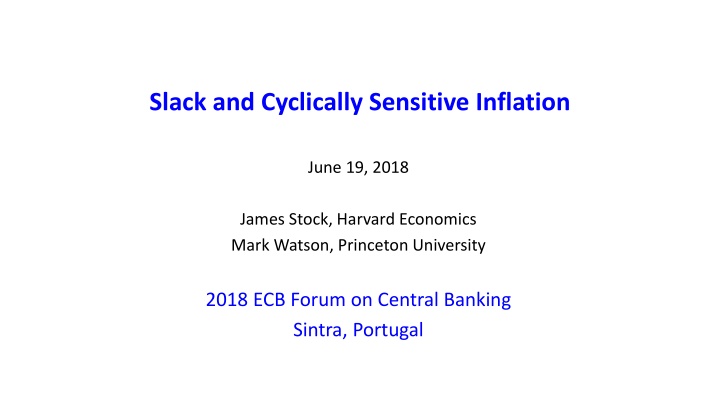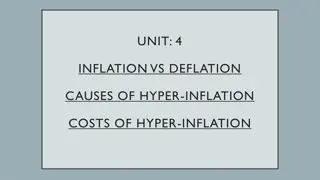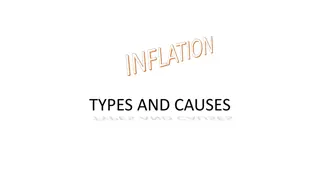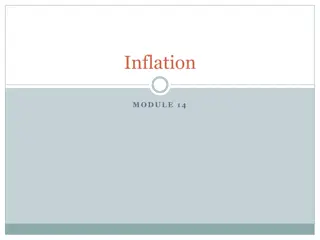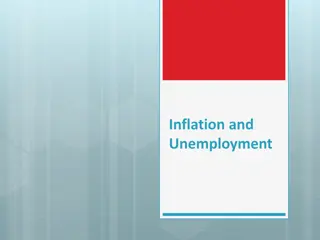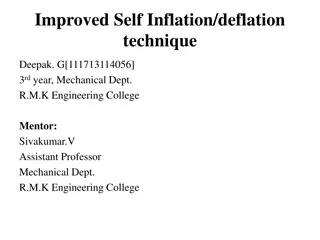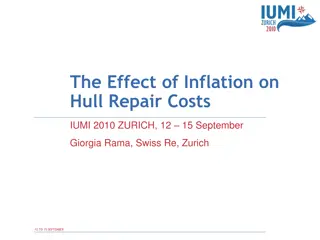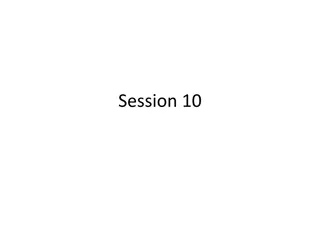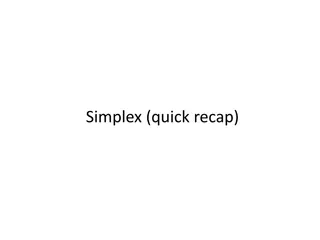Slack and Cyclically Sensitive Inflation Analysis
In this study presented at the 2018 ECB Forum on Central Banking in Sintra, Portugal, James Stock from Harvard Economics and Mark Watson from Princeton University analyze the cyclical pressure on inflation in the US and Euro Area. They discuss the potential resuscitation of the Phillips Curve using different slack measures and examine correlations and slopes with various gaps and the PCExFE indicator over different time periods.
Download Presentation

Please find below an Image/Link to download the presentation.
The content on the website is provided AS IS for your information and personal use only. It may not be sold, licensed, or shared on other websites without obtaining consent from the author.If you encounter any issues during the download, it is possible that the publisher has removed the file from their server.
You are allowed to download the files provided on this website for personal or commercial use, subject to the condition that they are used lawfully. All files are the property of their respective owners.
The content on the website is provided AS IS for your information and personal use only. It may not be sold, licensed, or shared on other websites without obtaining consent from the author.
E N D
Presentation Transcript
Slack and Cyclically Sensitive Inflation June 19, 2018 James Stock, Harvard Economics Mark Watson, Princeton University 2018 ECB Forum on Central Banking Sintra, Portugal
Where is the cyclical pressure on inflation? PCExFE US: Unemployment rate 4-quarter inflation PCE - total 1
Where is the cyclical pressure on inflation? Euro Area data: Unemployment rate 4-quarter inflation HICP x EuF HICP - total 2
The Flattening U.S. Phillips Curve using PCExFE & CBO unemployment gap Four-quarter changes of four- quarter inflation 2000-2018q1 1984-1999 1960-1983 3
Slack and Cyclically Sensitive Inflation Outline A. US Can the (aggregate) PC be resuscitated by using a different slack measure? (no) Do some components move cyclically (yes) Construct index of cyclically sensitive inflation (CSI) B. EA Do some components move cyclically (yes) Construct index of cyclically sensitive inflation (CSI) C. Discussion & implications Data comments All data are quarterly Inflation is 4-quarter inflation (e.g. Q1-to-Q1): Changes in inflation are 4-quarter change: = = 4 t 4 t 100ln( 4 t / ) P P 4 4 t 4 t t 4 4
US: Can the Phillips Curve be Resuscitated by Using a Different Slack Measure? Gaps and Slack The real-time gap problem (Orphanides & van Norden (2003)) Theory doesn t provide a single gap measure The depth of this recession might pose special problems for some slack measures We consider 7 gap measures: 2 CBO gaps, 5 two-sided smoother estimates of potential o Also gap index (1st principal component) 5
US: Contemporaneous Phillips correlations & slopes: various gaps & PCExFE (4Q change) Ex-post slack Correlation 1984- 1999 Slope (SE) 1984- 1999 1960- 1983 -0.52 -0.51 -0.57 -0.53 -0.56 -0.49 -0.64 -0.57 -0.49 -0.44 2000- 2018q1 -0.11 -0.24 -0.07 -0.25 -0.02 -0.03 -0.24 -0.14 -0.09 -0.24 1960- 1983 2000- 2018q1 -0.03 (0.04) -0.06 (0.04) -0.02 (0.04) -0.07 (0.05) -0.01 (0.04) -0.01 (0.04) -0.07 (0.03) -0.04 (0.04) -0.02 (0.04) -0.08 (0.06) Unemployment gap (CBO) -0.48 -0.47 (0.11) -0.31 (0.05) -0.60 (0.13) -0.38 (0.08) -0.73 (0.17) -0.74 (0.13) -0.52 (0.10) -0.53 (0.10) -0.28 (0.09) -0.18 (0.07) -0.29 (0.10) -0.22 (0.08) -0.24 (0.09) -0.25 (0.10) -0.23 (0.08) -0.25 (0.09) GDP gap (CBO) -0.35 Unemployment gap (two-sided -0.49 filtered) Short-term unemployment gap (two-sided filtered) Employment-population ratio (two-sided filtered) Employment-population ratio ages 25-54 (two-sided filtered) Capacity utlilization rate (two-sided -0.49 -0.44 -0.44 6 -0.45 filtered) Gap index -0.47 Real-time slack Unemployment rate -0.40 -0.43 (0.09) -0.30 (0.07) -0.20 (0.07) -0.14 (0.06) Short-term unemployment rate -0.35
Ex-post slack Correlation 1984- 1999 Slope (SE) 1984- 1999 1960- 1983 -0.52 -0.51 -0.57 2000- 2018q1 -0.11 -0.24 -0.07 -0.25 1960- 1983 2000- 2018q1 -0.03 (0.04) -0.06 (0.04) -0.02 (0.04) -0.07 (0.05) -0.01 (0.04) -0.01 (0.04) -0.07 (0.03) -0.04 (0.04) -0.02 (0.04) -0.08 (0.06) Unemployment gap (CBO) -0.48 -0.47 (0.11) -0.31 (0.05) -0.60 (0.13) -0.38 (0.08) -0.73 -0.28 (0.09) -0.18 (0.07) -0.29 (0.10) -0.22 (0.08) -0.24 GDP gap (CBO) -0.35 Unemployment gap (two-sided -0.49 filtered) US: Phillips correlations & slopes: various gaps, ctd Short-term unemployment gap -0.53 (two-sided filtered) Employment-population ratio -0.56 (two-sided filtered) Employment-population ratio ages -0.49 25-54 (two-sided filtered) Capacity utlilization rate (two-sided -0.64 filtered) Gap index -0.57 Real-time slack Unemployment rate -0.49 Short-term unemployment rate -0.44 -0.49 Ex-post slack Correlation 1984- 1999 -0.44 Slope (SE) 1984- 1999 (0.09) -0.25 (0.10) -0.23 (0.08) -0.25 (0.09) 1960- 1983 -0.52 -0.51 -0.57 -0.53 -0.56 -0.49 -0.64 -0.57 -0.49 -0.44 2000- 2018q1 -0.11 -0.24 -0.07 -0.25 -0.02 -0.03 -0.24 -0.14 -0.09 -0.24 1960- 1983 (0.17) -0.74 (0.13) -0.52 (0.10) -0.53 (0.10) 2000- 2018q1 -0.03 (0.04) -0.06 (0.04) -0.02 (0.04) -0.07 (0.05) -0.01 (0.04) -0.01 (0.04) -0.07 (0.03) -0.04 (0.04) -0.02 (0.04) -0.08 (0.06) -0.44 -0.02 -0.03 -0.24 -0.14 -0.09 -0.24 Unemployment gap (CBO) -0.48 -0.45 -0.47 (0.11) -0.31 (0.05) -0.60 (0.13) -0.38 (0.08) -0.73 (0.17) -0.74 (0.13) -0.52 (0.10) -0.53 (0.10) -0.28 (0.09) -0.18 (0.07) -0.29 (0.10) -0.22 (0.08) -0.24 (0.09) -0.25 (0.10) -0.23 (0.08) -0.25 (0.09) GDP gap (CBO) -0.35 -0.47 Unemployment gap (two-sided -0.49 -0.40 filtered) Short-term unemployment gap (two-sided filtered) Employment-population ratio (two-sided filtered) Employment-population ratio ages 25-54 (two-sided filtered) Capacity utlilization rate (two-sided -0.49 -0.43 (0.09) -0.30 (0.07) -0.20 (0.07) -0.14 (0.06) -0.44 -0.35 -0.44 7 -0.45 filtered) Gap index -0.47 Real-time slack Unemployment rate -0.40 -0.43 (0.09) -0.30 (0.07) -0.20 (0.07) -0.14 (0.06) Short-term unemployment rate -0.35
US: PCE Inflation Components: Measurement Issues & Cyclical Properties Sector Share (2000s) Subtotals We consider ~39% of consumption to have well- measured price inflation A. Well-measured Housing ex utilities Recreation services Food and beverages for off-premises consumption Food services and accommodations Housing - energy utilities component Gasoline and other energy goods B. Some information content Other services Other nondurable goods Transportation services Motor vehicles and parts Other durable goods Furnishings and durable household equipment Health care C. Poorly measured Financial services and insurance Clothing and footwear Recreational goods and vehicles NPISH 0.16 0.04 0.08 0.06 0.02 0.03 0.34 ~17% of consumption has poorly measured price inflation. 0.05 0.09 0.08 0.03 0.04 0.02 0.03 0.16 The main problems are: o New/improved goods o Use of input costs instead of consumer prices for some services o Lack of market prices for some services 0.29 0.16 0.08 0.03 0.03 0.03 0.17 8
US: Cyclical activity measures (32 quarter band-pass filtered) The cyclical activity index (CAI) is the first principal component of the 6 band- passed activity variables 9
US: Cyclical Properties of PCE Components: Four Examples Correlation = 0.46 Correlation = 0.48 Correlation = -0.11 Correlation = -0.09 Black: inflation component Blue: Cyclical Activity Index 10
US: Correlation of 4Q differences of 4Q inflation with Cyclical Activity Index Housing excluding gas & electric utilities 0.475 Food services & accommodations 0.463 Food and beverages purchased for off-premises consumption 0.426 Recreation services 0.278 Recreational goods and vehicles 0.255 Other services 0.153 NPISH 0.138 Gas & electric utilities 0.130 Other durable goods 0.100 Furnishings & durable household equipment 0.095 Other nondurable goods 0.061 Transportation services 0.019 Gasoline & other energy goods -0.040 Clothing & footwear -0.089 Health care -0.107 Financial services & insurance -0.114 Motor vehicles and parts -0.366 11
Cyclically Sensitive Inflation: Methods o Treat the Phillips curve as a statistical measurement problem Components each have different amounts of signal and noise o Incorporate judgmental assessment of measurement quality Eliminate Recreational goods & vehicles, Clothing & footwear, Financial services & insurance, and NPISH o CSI - single slack indicator approach What are the inflation index weights that yields the most cyclical inflation index? Estimate the regression, 13 13 i i = + 4 + = 4 it CAI v s.t. 1 and 0 1 t i t i i = = 1 1 12
US: Benchmark CSI specification using CAI estimated 1984-2018q1 Component Corr with CAI 0.475 0.463 CSI weight 0.627 0.040 Housing excluding gas & electric utilities Food services & accommodations Food and beverages purchased for off-premises consumption 0.426 0.159 Recreation services Recreational goods and vehicles Other services NPISH Gas & electric utilities Other durable goods Furnishings & durable household equipment Other nondurable goods Transportation services Gasoline & other energy goods Clothing & footwear Health care Financial services & insurance Motor vehicles and parts 0.278 0.255 0.153 0.138 0.13 0.1 0.095 0.061 0.019 -0.04 -0.089 -0.107 -0.114 -0.366 0.080 excluded 0.072 excluded 0.022 0 0 0 0 0 excluded 0 excluded 0 13
US: CSI, PCExFE, and PCE-all inflation (4 quarter inflation) 14
US: CSI Phillips correlations & slopes Ex-post slack Correlation 1984- 1999 Slope (SE) 1984- 1999 1960- 1983 -0.61 -0.62 -0.64 -0.62 -0.59 -0.50 -0.70 -0.65 -0.56 -0.52 2000- 2018q1 -0.32 -0.49 -0.32 -0.55 -0.19 -0.24 -0.64 -0.41 -0.30 -0.54 1960- 1983 2000- 2018q1 -0.16 (0.15) -0.25 (0.14) -0.15 (0.15) -0.29 (0.13) -0.09 (0.12) -0.12 (0.14) -0.35 (0.11) -0.21 (0.15) -0.15 (0.15) -0.37 (0.17) Unemployment gap (CBO) -0.34 -0.42 (0.10) -0.29 (0.08) -0.52 (0.12) -0.34 (0.09) -0.59 (0.15) -0.58 (0.15) -0.43 (0.08) -0.46 (0.11) -0.21 (0.10) -0.29 (0.13) -0.22 (0.10) -0.22 (0.10) -0.18 (0.09) -0.17 (0.11) -0.25 (0.12) -0.23 (0.10) GDP gap (CBO) -0.53 Unemployment gap (two-sided -0.36 filtered) Short-term unemployment gap (two-sided filtered) Employment-population ratio (two-sided filtered) Employment-population ratio ages 25-54 (two-sided filtered) Capacity utilization rate (two-sided -0.46 -0.31 -0.28 -0.47 filtered) Gap index -0.42 Real-time slack Unemployment rate -0.32 -0.38 (0.11) -0.28 (0.09) -0.17 (0.09) -0.14 (0.09) Short-term unemployment rate -0.34 15
EA CSI : Slack Measures and Cyclical Activity Index EA slack measures Unemployment gap (EC) Output gap (IMF) Band-passed activity variables: o GDP o Capacity utilization o Industrial production EA Cyclical Activity Index = average of three band-passed variables (standardized) 16
EA: HICP Components: 12 Second-Tier Components (Housing is ex energy) Correlation = 0.02 Correlation = 0.72 Correlation = 0.12 Correlation = 0.16 Black: inflation component Blue: Cyclical Activity Index 17
EA: Benchmark CSI specification using CAI estimated 1996-2018q1 Correlation between cyclical activity index and 4-qtr change in 4-qtr inflation Consumption share (2018) Component and HICP code CSI weight (wi) 0.125 Food & non-alcoholic beverages (01) 0.155 0.73 Alcohol, tobacco, & narcotics (02) 0.040 -0.05 0.000 Clothing & footwear (03) 0.059 0.16 0.000 Housing excluding energy (04x) 0.064 0.02 0.000 Furnishings, household items, & maintenance (05) 0.062 0.63 0.440 Health (06) 0.048 0.12 0.042 Transport goods & services (07) 0.154 0.21 0.043 Communications (08) 0.032 -0.06 0.000 Recreation & culture (09) 0.092 0.24 0.000 Education (10) 0.010 0.27 0.011 Restaurants & hotels (11) 0.098 0.72 0.338 Misc. goods & services (12) 0.092 0.35 0.000 18
EA CSI, HICPxEUF, and HICP-all inflation (4 quarter inflation) 19
Sensitivity check: Gap index instead of band-passed activity index 4-quarter inflation CSI with index weights estimated (band-passed, unemployment gap, output gap). 82% of the weight is on band-passed. CSI using gap index 20
Take-aways 1. Changing slack measures doesn t solve the PC puzzle (US) 2. Cyclical behavior varies substantially across components. In ways that largely make sense based on the nature of the markets (local v. global) and on measurement quality 3. Current outlook: US From 2013q1-2018q1, PCExFE is unchanged (1.5%), CSI has increased from 2.1% to 2.6% 4. Current outlook: EA CSI has different weights than HICPxEUF but recent behavior is very similar 2016q1-2018q1: EA-CSI increased from 0.9% to 1.2%, same as HICPxEUF 5. Next steps Implement monthly (12-month inflation) Work with third-tier components especially in EA (differentiate goods and services) Resolve conceptual/empirical issue: band-passed activity index or gap or ??? 21
US: Sensitivity check: Pre-sample stability Other sensitivity checks 1. Rolling regression 2. Use all 17 components 3. Constrained canonical correlations using all 7 band-pass activity variables 4. Use gap instead of band-passed activity indexes Corr = 0.57 Corr = 0.57 23
US: Sensitivity check: Gap index instead of band-passed activity index 4-quarter change of 4-quarter inflation CSI inflation index differs if gap index is used instead of band- passed. If activity weights and CSI weights are chosen simultaneously, the slack variable chosen is band- passed activity index not a gap! 24
US: PCE components and their shares, sorted by 2000-2014 share 1960- 2014 0.18 0.11 0.08 0.08 0.12 0.06 0.06 0.05 0.03 0.05 0.03 0.04 0.03 0.04 1960- 1979 0.17 0.07 0.08 0.08 0.16 0.05 0.06 0.06 0.02 0.07 0.03 0.04 0.03 0.04 1980- 1999 0.18 0.13 0.08 0.07 0.10 0.07 0.07 0.05 0.03 0.05 0.03 0.04 0.03 0.03 2000- 2014 0.18 0.16 0.09 0.08 0.08 0.08 0.06 0.04 0.04 0.03 0.03 0.03 0.03 0.03 Sector Housing and utilities Health care Other services Other nondurable goods Food and beverages for off-premises consumption Financial services and insurance Food services and accommodations Motor vehicles and parts Recreation services Clothing and footwear Recreational goods and vehicles Gasoline and other energy goods Transportation services Furnishings and durable household equipment Final consumption expenditures of nonprofit institutions serving households (NPISHs) Other durable goods 0.02 0.02 0.02 0.03 0.02 0.02 0.02 0.02 26
The PCE price index: a brief review of methods o The PCE price index is computed by the Bureau of Economic Analysis (BEA) Most component price series are CPI indexes for components, computed by the Bureau of Labor Statistics (BLS) Differences between PCE-PI and CPI: PCE concept is final consumption, CPI is out of pocket spending Share weights are from the NIPA surveys PCE-PI is revised for methodological changes (if possible), CPI is not Some divergence in price concepts, in which PCE uses PPI not CPI prices o The market price component of the CPI has 211 item strata Goods and services. Nondurables: < 3 yrs life. Services: cannot be inventoried. Main sampling rotation structures: a) food at home, lodging, most consumer end-energy goods, telephone services, used cars, some odds and ends: Single panel sample monthly b) Everything else except rent (most regions): 2 panels, alternating months c) rent: 6 panels, each sampled every 6 months The market price component of the CPI has 211 item strata Market-based CPI has several well-known problems New goods problem: no quality adjustment, just skip first month price Replacement goods problem: quality adjustment by (a) hedonic regression or, if not possible, (b) production cost 27
The PCE price index: a brief review of methods, ctd. o The PCE-PI and the CPI are also computed for sectors without posted market prices. There are various methodologies: The first step is defining the unit to be priced. For example For legal services: an end-consumer legal service (e.g. will), with a fixed production function (hours of attorney, legal aide, etc) and changing input wages; or, an hour of a law office s time For hospital services: a service bundle (e.g., 2 day stay + 1 cardiac catheterization + 2 EKGs + 2 IV doses blood thinner drug + ) These are priced from (randomly selected) bills or interviews Other price indexes for unpriced services include unpriced services of nonprofits (religious institutions, etc.), unpriced banking services (liquidity services) However, many services have market prices (Red Sox ticket; a room at Sonesta) o Special indexes: PCE-xE: excludes gasoline & other energy goods + energy utilities component of housing PCE-xFE: also excludes food at home (but not food at restaurants) Market-based CPI (excludes all non-market price estimates) 28
PCE (green) and component (orange): Housing ex energy util. (qtrly) 15 10 % at annual rate 5 0 -5 1960q1 1980q1 2000q1 2020q1 Rent paid by renters Actual market rent excluding utilities 6 rotating panels, surveyed every 6 months Price index(t) = This month s panel price relative price index(t-1) Owner-equivalent rent Post-1983: Actual market rent excluding utilities Pre-1983: Payment flows (mortgage payments, etc) 6 rotating panels, index construction as for renters Misc. Surveyed units fractionally represent rental and owned units Boarding schools, group homes use renter s rent index Utilities: CPI for water & sewer maint; CPI for garbage & trash collection 29
Housing: energy utilities 40 20 % at annual rate 0 -20 1960q1 1980q1 2000q1 2020q1 Electricity CPI for electricity Natural gas CPI for utllity-provided natural gas 30
Health care (expenditure share 2000-2016 = 0.16): CPI 15 10 % at annual rate 5 0 -5 1960q1 1980q1 2000q1 2020q1 CPI v. PCE CPI covers out-of-pocket medical (paid by consumers). PCE covers consumption of medical services. Most medical services in the U.S. do not have a market price they are negotiated health plan prices CPI: Outpatient physician s services, paramedics, hospitals, nursing homes Provision-of-services concept. CPI outpatient: price of visit for a specific illness. CPI hospital (post-87): price of bundle of services provided (3- day stay + 1 catheterization + 2 EKGs + ) by insurer reimbursement category. CPI pharma: by drug. Pre-87: cost of hospital inputs Dental & other medical CPI for dental services, CPI for other medical services 31
Health care (0.16): PCE 15 10 % at annual rate 5 0 -5 1960q1 1980q1 2000q1 2020q1 PPI concept PPI usually first transaction price rec d by producer. For health care, PPI since 1993 is DRG-based, broken out by service providers PCE: Physician services PPI for physician offices. Unit is office visit for a given condition PCE: hospital services PPI for hospitals. Unit is a hospital episode for a given condition PCE: nursing homes PPI for nursing homes. Cost of inputs basis (hourly wages etc.) PCE: paramedical PPI for paramedical 32 Dental & other medical Uses CPIs for dental services, for other medical services
Other services (0.09) 15 10 % at annual rate 5 0 -5 1960q1 1980q1 2000q1 2020q1 Communication CPI for wireless phone service, CPI for land line phone service Internet CPI for internet services Education CPI for college education; CPI for private primary & secondary schools Legal, accounting Cost basis (cost of 1 hr law office time, or mix of time for given service) Social services Cost basis, some CPI (child care) Misc. CPI for postage, CPI for funeral services, CPI for haircuts; net foreign travel (complicated) 33
Other nondurable goods (0.08) 20 15 % at annual rate 10 5 0 -5 1960q1 1980q1 2000q1 2020q1 Tobacco CPI-tobacco Pharmaceuticals CPIs for prescription & OTC drugs, CPI for med. eqpt sold to consumers Recreational nondurables CPIs for toys, plants & flowers, pets, photographic supplies, Personal care Various CPIs for personal care items Misc. home goods CPIs: newspapers & magazines, household supplies Spending abroad (net, including in-kind personal remittances) complicated, non-mkt 34
Food & beverages off-premises (0.08) 20 15 % at annual rate 10 5 0 -5 1960q1 1980q1 2000q1 2020q1 Food & nonalcoholic beverages, off-premises Detailed price components for food at home Alcohol, off-premises Various CPIs (beer, wine, distilled spirits) for off-premises 35
Financial services & insurance (0.08) 30 20 % at annual rate 10 0 -10 1960q1 1980q1 2000q1 2020q1 Financial services provided w/out payment Estimated based on imputed below-market interest on checking account. Alternative interest rate changed to stabilized (smoothed) rate in 2013, revised back to 1985 Financial fees CPI for checking account and other bank services (market prices). Insurance Price index is for the value of insurance services provided (risk pooling, intermediation) = all premiums expected losses; cost-based using PPI Brokers fees PPI (cost-based) 36
Food services & accommodations (0.06) 15 10 % at annual rate 5 0 -5 1960q1 1980q1 2000q1 2020q1 Purchased meals & beverages CPI for categories of purchased meals & beverages (restaurant meals, bars, fast food, etc) Institutional food & drink Use market-based CPI for purchased meals & beverages by category Accommodations CPI for purchased lodging away from home. Boarding at schools: separate (market-price) CPI 37
Motor vehicles & parts (0.04) 30 20 % at annual rate 10 0 -10 1960q1 1980q1 2000q1 2020q1 New cars & trucks CPI-new cars: sticker price + 30-day average dealer markup or discount. Year to year quality changes priced on production cost. Used cars & trucks Secondary source price data, with quality adjustments when new Parts CPI for tires; CPI for parts 38
Recreation services (0.04) 15 10 % at annual rate 5 0 -5 1960q1 1980q1 2000q1 2020q1 Sports centers & clubs, theaters, museums, etc. CPI for specific categories, e.g. club dues and fees; admission to sporting events. Monthly/bi-monthly/6-month sample Audio/video & info processing services CPI for cable & satellite TV; CPI for film processing; CPI for video/audio rental Other Gambling: CPI-U; pet care: CPI-veterinary services, etc. 39
Clothing & footwear (0.03) 15 10 % at annual rate 5 0 -5 1960q1 1980q1 2000q1 2020q1 Market purchased clothing Various CPIs. Note new/replacement goods issue however. Military & uniforms Cost-based 40
Recreational goods & vehicles (0.03) 15 10 % at annual rate 5 0 -5 -10 1960q1 1980q1 2000q1 2020q1 Video, audio, home computers Various CPIs including CPI for home computers, CPI for computer software and accessories, and CPI for consumer digital communications and information processing eqpt Sporting eqp CPI for sporting eqpt Recreational books CPI for recreational books Musical instruments CPI for musical instruments 41
Gasoline & other energy goods (0.03) 150 100 % at annual rate 50 0 -50 -100 1960q1 1980q1 2000q1 2020q1 Motor fuels CPI for motor fuels Other fuels CPIs for propane, kerosene, wood 42
Transportation services (0.03) 20 15 % at annual rate 10 5 0 -5 1960q1 1980q1 2000q1 2020q1 Airline travel PPI (cost-based: passenger revenues/total passenger-miles) (however CPI is based on actual prices, currently sampled off the Web) Intracity CPI (covers taxis, busses, etc.) Intercity busses, trains CPI (market prices) Water CPI (ferries, etc.) 43
Furnishings & household durables (0.03) 15 10 % at annual rate 5 0 -5 1960q1 1980q1 2000q1 2020q1 Furniture & bedding CPI for furniture & bedding; CPI for clocks & lamps; related CPIs Household appliances Various CPIs Tools, house & garden eqpt Various CPIs 44
Other durable goods (0.02) Misc. durable goods Watches, jewelry, educational books, luggage, telephone equipment. All based on CPIs (market prices) 45
Final consumption expenditures of nonprofit institutions serving households (NPISHs) (0.03) 20 10 % at annual rate 0 -10 -20 1960q1 1980q1 2000q1 2020q1 NPISH definition Current operating expenditures by nonprofits less sales to households and other sectors. Prices By construction, essentially everything in NPISHs does not have a market price, so costs of inputs are used for priced outputs. Example: price of 1 hour of a minister s time = minister s hourly wage 46
